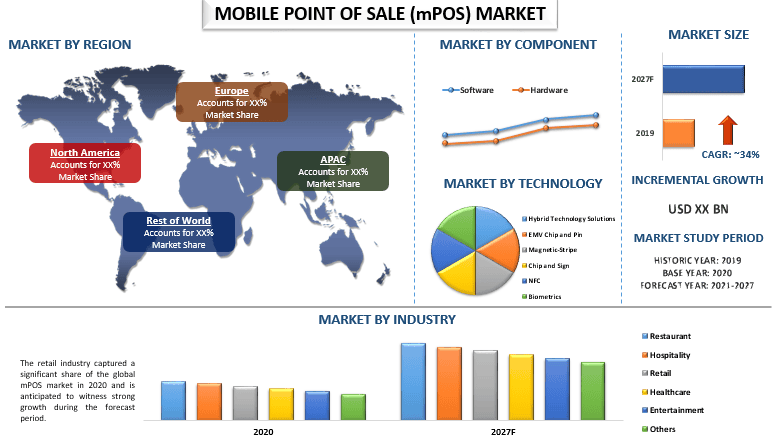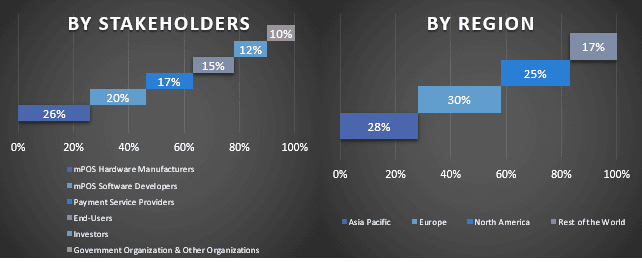- Trang chủ
- Về chúng tôi
- Ngành
- Dịch vụ
- Đọc
- Liên hệ với chúng tôi
Thị trường Điểm bán hàng di động (mPOS): Phân tích hiện tại và Dự báo (2021-2027)
Tập trung vào Thành phần (Phần mềm và Phần cứng); Công nghệ (Giải pháp Công nghệ Hybrid, Chip và Mã PIN EMV, Dải từ, Chip và Chữ ký, NFC và Sinh trắc học); Ngành (Nhà hàng, Khách sạn, Bán lẻ, Chăm sóc sức khỏe, Giải trí và Các ngành khác); và Khu vực/Quốc gia

Thị trường mPOS toàn cầu dự kiến sẽ đạt tốc độ CAGR khoảng 34% trong giai đoạn 2021-2027. Thị trường mPOS toàn cầu đang tăng lên do những đổi mới ngày càng tăng trong phương thức thanh toán, sự thay đổi trong phương thức thanh toán bán lẻ từ tiền mặt sang phương thức điện tử và khả năng kết nối của mPOS với điện thoại thông minh hoặc máy tính bảng bằng đầu đọc thẻ di động không dây. Hơn nữa, việc tăng cường đầu tư vào mPOS sẽ tác động tích cực đến thị trường của nó. mPOS là điện thoại thông minh, máy tính bảng hoặc thiết bị không dây chuyên dụng thực hiện không dây các chức năng của máy tính tiền hoặc thiết bị đầu cuối điểm bán hàng (POS). Nó rất hữu ích cho các doanh nghiệp thực hiện giao dịch khi đang di chuyển. Ví dụ: nó hữu ích cho các doanh nghiệp tương tác với khách hàng từ các địa điểm khác với vị trí địa lý của tổ chức. Hơn nữa, chi phí của hệ thống mPOS mang lại cho chúng lợi thế hơn so với hệ thống POS. Ví dụ: theo nhà cung cấp POS Magestore, chi phí của một hệ thống POS là khoảng 3.000–10.000 USD, giá chính xác phụ thuộc vào loại phần cứng, phần mềm POS và mức độ tùy chỉnh đã chọn, trong khi mPOS có thể từ hoàn toàn miễn phí đến gần 200 đô la mỗi tháng.
Bixolon Co. Ltd., Citizen Systems Europe GmbH, Dspread Technology (Beijing) Inc., Hewlett Packard Enterprise Development LP, INGENICO Group S.A., Intuit Inc., PayPal Inc., Oracle Corporation, Pax Technology Ltd. và Posiflex Technology Inc. là một số công ty chủ chốt trên thị trường. Một số thương vụ M&A cùng với các mối quan hệ đối tác đã được thực hiện bởi những người chơi này để tạo điều kiện cho khách hàng các sản phẩm/công nghệ công nghệ cao và cải tiến.
Thông tin chi tiết được trình bày trong báo cáo
“Trong số các thành phần, phân khúc phần mềm chiếm thị phần nổi bật trên thị trường vào năm 2020”
Trên cơ sở thành phần, thị trường được chia thành phần mềm và phần cứng. Trong số hai loại này, phân khúc đầu đọc thẻ thông minh chiếm một thị phần đáng kể trên thị trường mPOS toàn cầu vào năm 2020 và dự kiến sẽ chứng kiến sự tăng trưởng đáng kể trong giai đoạn dự báo do việc áp dụng ngày càng nhiều các giải pháp mPOS dựa trên phần mềm trên toàn cầu do tính dễ tiếp cận và chi phí thấp của phần mềm. Hơn nữa, phần mềm hoặc ứng dụng mPOS cung cấp cho người bán một giải pháp chấp nhận thanh toán không tiếp xúc đơn giản và hiệu quả về chi phí, sử dụng điện thoại thông minh hoặc máy tính bảng mà họ đã sở hữu.
“Trong số các công nghệ, phân khúc chip và mã pin EMV chiếm một thị phần nổi bật trên thị trường vào năm 2020”
Dựa trên công nghệ, thị trường được phân loại thành các giải pháp công nghệ hỗn hợp, chip và mã pin EMV, dải từ tính, chip và chữ ký, NFC và sinh trắc học. Trong số đó, chip và mã pin EMV chiếm một thị phần nổi bật trên thị trường mPOS toàn cầu và dự kiến sẽ chứng kiến sự tăng trưởng có ảnh hưởng trong giai đoạn dự báo, chủ yếu là do nó làm giảm đáng kể nguy cơ gian lận, giúp các giao dịch trực tuyến và ngoại tuyến an toàn hơn nhiều cho người tiêu dùng.
“Bắc Mỹ chứng kiến sự tăng trưởng đáng kể trong giai đoạn dự báo”
Bắc Mỹ chiếm một thị phần nổi bật trên thị trường mPOS toàn cầu vào năm 2020 và dự kiến sẽ thể hiện tốc độ tăng trưởng nổi bật trong giai đoạn dự báo. Sự tăng trưởng của thị trường này có thể là do sự hiện diện của những người chơi chính trên thị trường trong khu vực và việc nhanh chóng áp dụng các công nghệ mới. Khu vực này là nơi tập trung một số nhà cung cấp giải pháp mPOS lớn, chẳng hạn như Hewlett Packard Enterprise Development LP, Oracle Corporation, Intuit Inc., PayPal Inc., và những nhà cung cấp khác đang đầu tư mạnh vào việc phát triển các hệ thống điểm bán hàng di động tiên tiến. Hơn nữa, sự phát triển của các ngành bán lẻ, nhà hàng, khách sạn và giải trí đang góp phần vào sự tăng trưởng của thị trường mPOS trong khu vực.
Lý do nên mua báo cáo này:
- Nghiên cứu bao gồm phân tích kích thước thị trường và dự báo được xác thực bởi các chuyên gia hàng đầu trong ngành đã được xác thực.
- Báo cáo trình bày một đánh giá nhanh về hiệu suất tổng thể của ngành trong nháy mắt.
- Báo cáo bao gồm phân tích chuyên sâu về các đối thủ trong ngành nổi bật với trọng tâm chính là tài chính kinh doanh chính, danh mục sản phẩm, chiến lược mở rộng và các phát triển gần đây.
- Xem xét chi tiết các yếu tố thúc đẩy, hạn chế, xu hướng chính và cơ hội hiện hành trong ngành.
- Nghiên cứu bao gồm toàn diện thị trường trên các phân khúc khác nhau.
- Phân tích sâu ở cấp độ khu vực của ngành.
Tùy chọn tùy chỉnh:
Thị trường mPOS toàn cầu có thể được tùy chỉnh thêm theo yêu cầu hoặc bất kỳ phân khúc thị trường nào khác. Bên cạnh đó, UMI hiểu rằng bạn có thể có nhu cầu kinh doanh riêng, do đó, vui lòng liên hệ với chúng tôi để nhận được một báo cáo hoàn toàn phù hợp với yêu cầu của bạn.
Mục lục
Phương Pháp Nghiên Cứu Phân Tích Thị Trường Điểm Bán Hàng Di Động (mPOS) (2021-2027)
Phân tích thị trường lịch sử, ước tính thị trường hiện tại và dự báo thị trường tương lai của thị trường mPOS toàn cầu là ba bước chính được thực hiện để tạo và phân tích việc áp dụng mPOS ở các khu vực lớn trên toàn cầu. Nghiên cứu thứ cấp toàn diện đã được thực hiện để thu thập các số liệu thị trường lịch sử và ước tính quy mô thị trường hiện tại. Thứ hai, để xác thực những hiểu biết sâu sắc này, nhiều phát hiện và giả định đã được xem xét. Hơn nữa, các cuộc phỏng vấn sơ cấp toàn diện cũng đã được thực hiện với các chuyên gia trong ngành trên toàn bộ chuỗi giá trị của thị trường mPOS toàn cầu. Sau khi giả định và xác thực các số liệu thị trường thông qua các cuộc phỏng vấn sơ cấp, chúng tôi đã sử dụng phương pháp tiếp cận từ trên xuống/từ dưới lên để dự báo quy mô thị trường hoàn chỉnh. Sau đó, các phương pháp phân tích chi tiết thị trường và phân tích tam giác dữ liệu đã được áp dụng để ước tính và phân tích quy mô thị trường của các phân khúc và phân đoạn phụ của ngành có liên quan. Phương pháp luận chi tiết được giải thích dưới đây:
Phân Tích Quy Mô Thị Trường Lịch Sử
Bước 1: Nghiên Cứu Chuyên Sâu về Các Nguồn Thứ Cấp:
Nghiên cứu thứ cấp chi tiết đã được thực hiện để thu thập quy mô thị trường lịch sử của thị trường mPOS thông qua các nguồn nội bộ của công ty như báo cáo thường niên & báo cáo tài chính, thuyết trình hiệu suất, thông cáo báo chí, v.v., và các nguồn bên ngoài bao gồm tạp chí, tin tức & bài báo, ấn phẩm của chính phủ, ấn phẩm của đối thủ cạnh tranh, báo cáo ngành, cơ sở dữ liệu của bên thứ ba và các ấn phẩm đáng tin cậy khác.
Bước 2: Phân Khúc Thị Trường:
Sau khi thu được quy mô thị trường lịch sử của thị trường mPOS, chúng tôi đã tiến hành phân tích thứ cấp chi tiết để thu thập thông tin chi tiết và chia sẻ thị trường lịch sử cho các phân khúc & phân đoạn phụ khác nhau cho các khu vực chính. Các phân khúc chính bao gồm trong báo cáo là thành phần, công nghệ và ngành. Phân tích cấp quốc gia sâu hơn đã được thực hiện để đánh giá mức độ chấp nhận chung của các mô hình thử nghiệm trong khu vực đó.
Bước 3: Phân Tích Yếu Tố:
Sau khi thu được quy mô thị trường lịch sử của các phân khúc và phân đoạn phụ khác nhau, chúng tôi đã tiến hành phân tích yếu tố chi tiết để ước tính quy mô thị trường hiện tại của thị trường mPOS. Hơn nữa, chúng tôi đã tiến hành phân tích yếu tố bằng cách sử dụng các biến phụ thuộc và độc lập như khả năng mPOS kết nối với điện thoại thông minh hoặc máy tính bảng với đầu đọc thẻ di động không dây và sự tiện lợi khi sử dụng thiết bị POS di động. Một phân tích kỹ lưỡng đã được thực hiện cho các kịch bản phía cung và phía cầu, xem xét các quan hệ đối tác hàng đầu, sáp nhập và mua lại, mở rộng kinh doanh và ra mắt sản phẩm trong lĩnh vực thị trường mPOS trên toàn cầu.
Ước Tính & Dự Báo Quy Mô Thị Trường Hiện Tại
Định cỡ Thị Trường Hiện Tại: Dựa trên những hiểu biết sâu sắc có thể hành động từ 3 bước trên, chúng tôi đã đưa ra quy mô thị trường hiện tại, những người chơi chính trên thị trường mPOS toàn cầu và thị phần của các phân khúc. Tất cả các phần trăm chia sẻ bắt buộc và phân tích chi tiết thị trường đã được xác định bằng phương pháp thứ cấp đã đề cập ở trên và được xác minh thông qua các cuộc phỏng vấn sơ cấp.
Ước Tính & Dự Báo: Đối với ước tính và dự báo thị trường, trọng số đã được gán cho các yếu tố khác nhau bao gồm các động lực & xu hướng, hạn chế và cơ hội có sẵn cho các bên liên quan. Sau khi phân tích các yếu tố này, các kỹ thuật dự báo có liên quan, tức là phương pháp tiếp cận từ trên xuống/từ dưới lên đã được áp dụng để đưa ra dự báo thị trường khoảng năm 2027 cho các phân khúc và phân đoạn phụ khác nhau trên các thị trường lớn trên toàn cầu. Phương pháp nghiên cứu được áp dụng để ước tính quy mô thị trường bao gồm:
- Quy mô thị trường của ngành, về doanh thu (USD) và tỷ lệ chấp nhận của thị trường mPOS trên các thị trường lớn trong nước
- Tất cả các phần trăm chia sẻ, phân tích và phân chia các phân khúc và phân đoạn phụ của thị trường
- Những người chơi chính trên thị trường mPOS toàn cầu về các giải pháp được cung cấp. Ngoài ra, các chiến lược tăng trưởng được các công ty này áp dụng để cạnh tranh trên thị trường đang phát triển nhanh chóng
Xác Thực Quy Mô và Thị Phần Thị Trường
Nghiên Cứu Sơ Cấp: Các cuộc phỏng vấn chuyên sâu đã được thực hiện với những người dẫn đầu quan điểm chủ chốt (KOL) bao gồm các Giám đốc điều hành Cấp cao (CXO/VP, Trưởng bộ phận Bán hàng, Trưởng bộ phận Tiếp thị, Trưởng bộ phận Vận hành, Trưởng khu vực, Trưởng quốc gia, v.v.) trên khắp các khu vực chính. Các phát hiện nghiên cứu sơ cấp sau đó đã được tóm tắt và phân tích thống kê đã được thực hiện để chứng minh giả thuyết đã nêu. Thông tin đầu vào từ nghiên cứu sơ cấp đã được hợp nhất với các phát hiện thứ cấp, do đó biến thông tin thành những hiểu biết sâu sắc có thể hành động.
Phân Chia Người Tham Gia Sơ Cấp ở Các Khu Vực Khác Nhau

Kỹ Thuật Thị Trường
Kỹ thuật phân tích tam giác dữ liệu đã được sử dụng để hoàn thành ước tính thị trường tổng thể và đưa ra các số liệu thống kê chính xác cho từng phân khúc và phân đoạn phụ của thị trường mPOS toàn cầu. Dữ liệu đã được chia thành nhiều phân khúc & phân đoạn phụ sau khi nghiên cứu các thông số và xu hướng khác nhau trong các lĩnh vực thành phần, công nghệ và ngành trong thị trường mPOS toàn cầu.
Mục tiêu chính của Nghiên cứu Thị trường mPOS Toàn cầu
Các xu hướng thị trường hiện tại & tương lai của thị trường mPOS toàn cầu đã được xác định chính xác trong nghiên cứu. Các nhà đầu tư có thể thu được những hiểu biết sâu sắc về chiến lược để làm cơ sở cho sự thận trọng của họ đối với các khoản đầu tư từ phân tích định tính và định lượng được thực hiện trong nghiên cứu. Các xu hướng thị trường hiện tại và tương lai đã xác định sức hấp dẫn tổng thể của thị trường ở cấp khu vực, cung cấp một nền tảng cho người tham gia công nghiệp khai thác thị trường chưa được khai thác để hưởng lợi như một lợi thế của người đi đầu. Các mục tiêu định lượng khác của các nghiên cứu bao gồm:
- Phân tích quy mô thị trường hiện tại và dự báo của thị trường mPOS về Giá trị (USD). Ngoài ra, hãy phân tích quy mô thị trường hiện tại và dự báo của các phân khúc và phân đoạn phụ khác nhau
- Các phân khúc trong nghiên cứu bao gồm các lĩnh vực thành phần, công nghệ và ngành.
- Xác định và phân tích khuôn khổ pháp lý cho ngành thị trường mPOS.
- Phân tích chuỗi giá trị liên quan đến sự hiện diện của các trung gian khác nhau, cùng với việc phân tích hành vi của khách hàng và đối thủ cạnh tranh của ngành.
- Phân tích quy mô thị trường hiện tại và dự báo của thị trường mPOS cho khu vực chính.
- Các quốc gia chính của các khu vực được nghiên cứu trong báo cáo bao gồm Châu Á Thái Bình Dương, Châu Âu, Bắc Mỹ và Phần còn lại của Thế giới.
- Hồ sơ công ty của thị trường mPOS và các chiến lược tăng trưởng được những người chơi trên thị trường áp dụng để duy trì trên thị trường đang phát triển nhanh chóng
- Phân tích sâu cấp khu vực của ngành
Liên quan Báo cáo
Khách hàng đã mua mặt hàng này cũng đã mua










